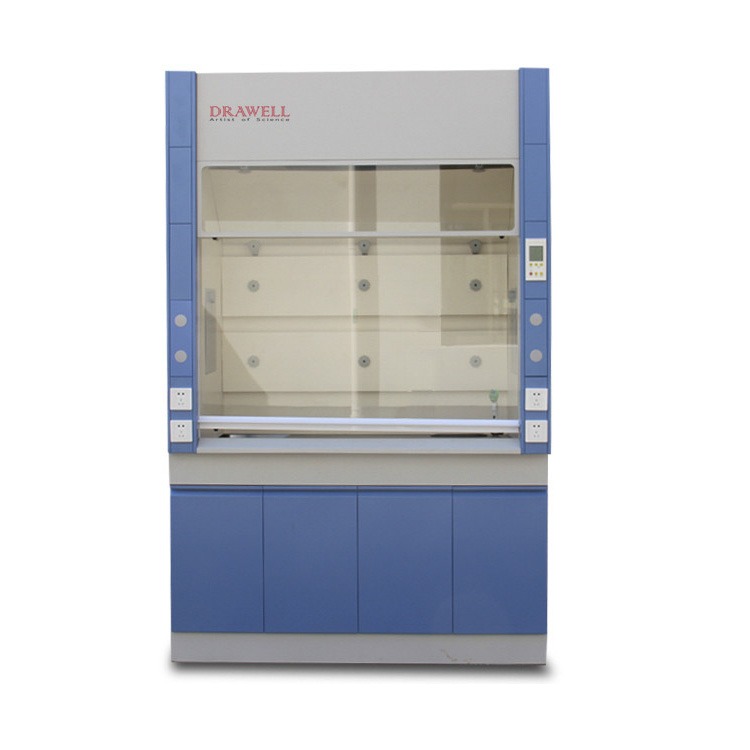Laboratory Furniture
Laboratory furniture refers to Laminar Flow Cabinets, PCR cabinets, Biosafety cabinets, and Fume Hoods made of specific materials and structures to meet experimental needs. Laboratory furniture is different from household furniture. It is often in contact with water, electricity, gas, chemicals, materials, and instruments and equipment. Therefore, higher requirements are placed on the structure and materials of furniture. When building a laboratory, attention must be paid to the design and selection of laboratory furniture.
Drawell mainly provides three types of laboratory furniture: Laminar Flow Cabinets, Biosafety Cabinets, and Fume Hoods.
Types of Laboratory Furniture
Laminar Flow Cabinet
The Laminar Flow Cabinet uses a fan to suck air into the pre-filter, enters the high-efficiency filter through the static pressure box, and sends the filtered air out in a vertical or horizontal airflow state, so that the operating area reaches Class 100 cleanliness and ensures the production requirements for environmental cleanliness.
Features of Laboratory Furniture
- Special design and treatment of harmful waste gas and wastewater that may be generated by test equipment to ensure the health of test personnel
- Scientifically design the laboratory exhaust system so that the laboratory air change rate and fume hood wind speed meet the requirements of international standards.
- Corrosion resistance: Laboratory furniture needs to be in contact with acids, alkalis, and corrosive chemicals, so corrosion-resistant materials such as stainless steel are used to ensure that they will not rust or deform after long-term use.
- Easy to clean and disinfect: The smooth surface is easy to clean and meets the needs of high-frequency disinfection. It is especially suitable for laboratories with high cleanliness requirements such as biology and medicine.
- The laboratory table is equipped with guardrails, splash-proof glass, etc., and the fume hood adopts an independent exhaust system to ensure that harmful gases are discharged in time and protect the health of operators.
Applications of Laboratory Furniture
Laboratory furniture has a wide range of applications, covering multiple fields and scenarios. Its main functions are to ensure experimental safety, improve operational efficiency and meet the needs of different environments.
- Scientific research institutions: Used in basic research, applied research and key laboratories, supporting experimental needs in the fields of materials science, life science, environmental science, etc.
- Educational institutions: Teaching laboratory classrooms in colleges and vocational training institutions, used for experimental teaching in chemistry, biology, physics and other subjects.
- Medical institutions and pharmaceutical factories: Professional fields such as medical laboratory, environmental monitoring station, nuclear safety laboratory, etc., meet special needs such as medical testing and environmental sample analysis.
- Enterprise R&D center: Enterprise product development, quality inspection and other links, support process optimization, new product development and other work.

What Are The Differences Between These Three Types of Laboratory Furniture?
(1) Different objects of protection
- The Laminar Flow Cabinet protects experimental samples (such as cells and microbial cultures) from contamination, and prevents pollutants released by the samples from contaminating the environment.
- The Biosafety Cabinets are mainly used to prevent aerosol diffusion and splash contamination when handling high-risk biological materials such as primary cultures and bacterial strains.
- The Fume Hood is mainly used to protect the chemical laboratory environment and personnel, and prevent the spread of corrosive gases or toxic fumes.
(2) Different working principles
- The Laminar Flow Cabinet: A clean area is formed by vertical or horizontal laminar air flow. After the microbial samples are placed, the laminar air will blow them towards the operator, which poses a “contamination risk”.
- The Biosafety Cabinets: A negative pressure filtration system is used. The air is filtered and discharged after being filtered by a high-efficiency filter to form a negative pressure environment to prevent the leakage of microbial aerosols.
- The Fume Hood: Negative pressure is generated by the fan, and the air in the cabinet is extracted and filtered before being discharged to prevent pollutants in the cabinet from spreading to the outside world4.
(3) Application
- The Laminar Flow Cabinet: Laboratories that require high cleanliness, such as cell culture, microbial testing, and pharmaceutical preparations.
- The Biosafety Cabinets: biomedical research, pathogen detection, infectious sample manipulation, etc.
- The Fume Hood: chemical laboratories, pharmaceuticals, environmental monitoring, and other experiments involving corrosive or toxic substances.
Why Choose US?
- Rich categories.
- The products are market-oriented and exported to many countries in the world
- Perfect sales system, efficient and fast after-sales service
- On-time delivery rate reaches 100%
- High cost performance





